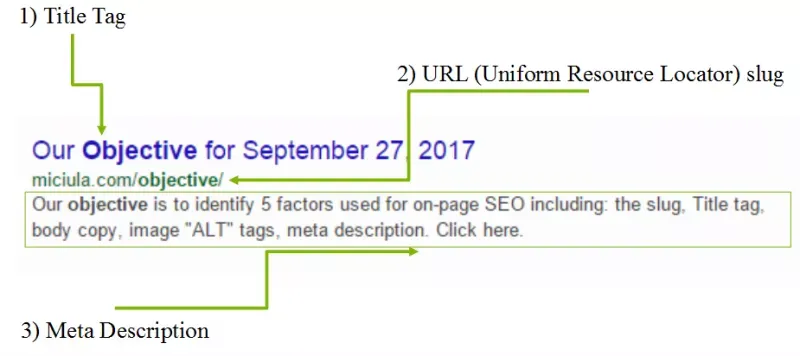On-Page Search Engine Optimization
By now, you have probably heard of SEO or search engine optimization. You have heard that SEO can increase traffic to your website, strengthen your brand image, and most importantly increase your sales.
This is all true! Many companies would rather have their listings organically move their way up Google’s SERP (Search Engine Results Page) to see such results, as opposed to participating in Google’s PPC. This means no money for advertising!
By applying these five easy principles to your SEO, your listing will not only work its way to the top, but you will also see instant results!
Creating a Webpage with On-page SEO
For on-page SEO, Google considers five factors that are of importance. The five factors include:
1. The Link (URL) Slug
This is the address of a website. Our recommendation is to practice writing your URL. It is best practice to write your URL to rank for your keywords. Search engines store a webpage’s URL and use it to identify attributes of the web page.
2. Title Tag
These define the titles of a document, and there are many things to consider as title tags are very important in helping pages rank:
- Keep titles between 50-60 characters.
- Longer titles are often more effective.
- Place important keywords close to the front of the title tag.
- Keep in mind the emotional impact to pull in users to associate with your brand.
3. Body Copy
Do research into keywords and find what types of search queries are most common with your brand and its region and language. Keywords, regardless whether they are primary or secondary should be chosen to reflect the content of the page. Keep in mind that it is possible to over optimize a page. While this sounds great, it is essentially harmful to your content. By using too many keywords (high keyword density) within the content, you are ranking but not providing enough relevant content to help your visitor. Other factors like word count (over 300) and readability also contribute to page optimization.
4. Image “ALT” Tags
Not only do images help strengthen the content and message of a page but also help in SEO. The ALT tags describe the image and help in ranking. When users visit the images tab in Google, your image will show and makes your website accessible to them. Therefore, it is important to have your keywords describing images.
5. Meta Description
Meta descriptions do not appear on your web page but are hidden text elements on your page that are used to describe your site on search engines. Use your keywords in your meta description as they will help enhance a web page’s click-through rate (CTR).
Google spiders crawl web pages and pull information to put into their algorithms; to help rank web pages for specified keywords. Along with the tips above, it is important to focus on the content; have content that is applicable and relevant. The image below shows the components of a search listing and how it correlates to a web page and the principles we mentioned.

These basic steps get your foot in the door for SEO. We recommend that you apply these principles to all your web pages if possible. Some may find it tedious, but by altering a few small things will lead to a big difference. Surely, these tips have been helpful to get you on the right track for optimizing your web pages. Remember, let the qualified leads come to you!